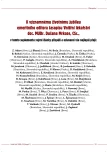Prothrombotic state in NAFLD and its consequences
Authors:
A. Hvizdáková; M. Vyskočil; Ľ. Kekeňák; E. Kováčová; H. Kratochvíľová; M. Boča
Authors‘ workplace:
I. interná klinika Lekárskej fakulty UK a FNsP Bratislava, Slovenská republika, prednostka doc. MUDr. Soňa Kiňová, PhD.
Published in:
Vnitř Lék 2009; 55(Suppl 1)(Supplementum 1): 94-96
Overview
Non-alcoholic fatty liver disease (NAFLD) is the most common liver disease in population. NAFLD is one part of metabolic syndrome (MS). The liver plays the role in haemostasis by the synthesis of coagulant, anticoagulant factors and haemostasis regulation. It seems recently, that there are prothrombic changes in haemostasis in patients with MS and NAFLD. They are caused by endothelial dysfunction, hypofibrinolysis and hypercoagulant state. Prothrombotic state in patients with NAFLD can by means of the insulin resistance increase cardiovascular risk as well as the risk of thromboembolism. The formation of microthrombi in hepatic vessels can participate also in progression of simple steatosis to steatofibrosis and liver cirrhosis.
Key words:
NAFLD – endothelial dysfunction – prothrombotic state – cardiovascular risk
Sources
1. Hvizdáková A, Boča M, Brnka R. Nealkoholová tuková choroba pečene (NAFLD) – choroba, ktorá sa v praxi často podceňuje. Inter Med 2008; 4: 227–232.
2. Brodanová M, Kordač V. Klinická hepatologie. Praha: Grada Avicenum 1993: 40–43.
3. Esper RJ, Nordaby RA, Vilariño JO et al. Endothelial dysfunction: a comprehensive appraisal. Cardiovasc Diabetol 2006; 5: 4.
4. Takase B, Matsushima Y, Uehata A et al. Endothelial dysfunction, carotid artery plaque burden, and conventional exercise‑induced myocardial ischemia as predictors of coronary artery disease prognosis. Cardiovasc Ultrasound 2008; 6: 61.
5. Brea A, Mosquera D, Martín E et al. Nonalcoholic fatty liver disease is associated with carotid atherosclerosis: a case-control study. Arterioscler Thromb Vasc Biol 2005; 25: 1045–1050.
6. Villanova N, Moscatiello S, Ramilli S et al. Endothelial dysfunction and cardiovascular risk profile in nonalcoholic fatty liver disease. Hepatology 2005; 42: 473–480.
7. Yildirim A, Soylu Ö, Aydin A et al. The relationship between endothelial dysfunction and serum aminotransferase levels in nonalcoholic fatty liver disease. Türk Kardiyol Dern Arş 2007; 35: 354–359.
8. Targher G. Non-alcoholic fatty liver disease as a determinant of cardiovascular disease. Atherosclerosis 2007; 190: 18–19.
9. Vaughan DE. PAI‑1 and atherothrombosis. J Thromb Haemost 2005; 3: 1879–1883.
10. Skurk T, Hauner H. Obesity and impaired fibrinolysis: role of adipose production of plasminogen activator inhibitor-1. Int J Obes Relat Metab Disord 2004; 28: 1357–1364.
11. Marchesini G, Bugianesi E, Forlani G et al. Non-alcoholic steatohepatitis in patients cared in metabolic units. Diabetes Res Clin Pract 2004; 63: 143–151.
12. Targher G, Bertolini L, Scala L et al. Non-alcoholic hepatic steatosis and its relation to increased plasma biomarkers of inflammation and endothelial dysfunction in non‑diabetic men. Role of visceral adipose tissue. Diabet Med 2005; 22: 1354–1358.
13. Derosa G, Gaddi AV, Piccinni MN et al. Antithrombotic effects of rosiglitazone-metformin versus glimepiride-metformin combination therapy in patients with type 2 diabetes mellitus and metabolic syndrome. Pharmacotherapy 2005; 25: 637–645.
14. Bahia L, Aguiar LG, Villela N et al. Relationship between adipokines, inflammation, and vascular reactivity in lean controls and obese subjects with metabolic syndrome. Clinics 2006; 61: 433–440.
15. Durina J, Remkova A. Prothrombotic state in metabolic syndrome. Bratisl Lek Listy 2007; 6: 279–280.
16. Bajzar L. Thrombin activatable fibrinolysis inhibitor and an antifibrinolytic pathway. Arterioscler Thromb Vasc Biol 2000; 20: 2511–2518.
17. Vischer UM. Von Willebrand factor, endothelial dysfunction, and cardiovascular disease. J Thromb Haemost 2006; 4: 1186–1193.
18. Assy N, Bekirov I, Mejritsky Y et al. Association between thrombotic risk factors and extent of fibrosis in patients with non‑alcoholic fatty liver diseases. World J Gastroenterol 2005; 11: 5834–5839.
19. Kurihara T, Deguchi S, Kato J et al. Impaired blood rheology by remnant‑like lipoprotein particles: Studies in patients with fatty liver disease. Clin Hemorheol Microcirc 2001; 24: 217–225.
20. Northup PG, Sundaram V, Fallon MB et al. Hypercoagulation and thrombophilia in liver disease. J Thromb Haemost 2007; 6: 2–9.
21. Wanless IR, Shiota K. The pathogenesis of nonalcoholic steatohepatitis and other fatty liver diseases: a four-step model including the role of lipid release and hepatic venular obstruction in the progression to cirrhosis. Semin Liver Dis 2004; 24: 99–106.
Labels
Diabetology Endocrinology Internal medicineArticle was published in
Internal Medicine

2009 Issue Supplementum 1
Most read in this issue
- Differential diagnosis of eosinophilia
- Iron overlo ad – recent advances in pathogenesis and tre atment
- Histiocytic disorders
- Acute upper gastro intestinal bleeding
